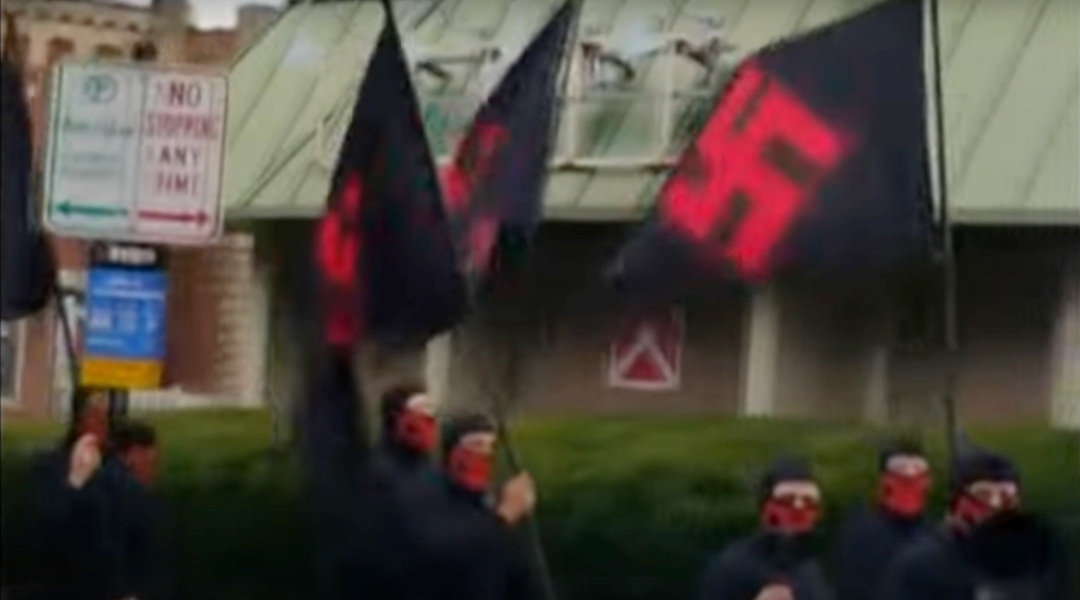In the Shadow of The Winter Garden
A diabolical terrorist plot had just been thwarted in London, the latest Arab-Israeli war was raging and a storm had struck the city the previous night. But to the crowd gathered at West 51st St. and Broadway in New York City on the afternoon of August 11, the presence of blue skies — nothin’ but blue skies — was evidence of a special providence. Most of the people belonged to the International Al Jolson Society and the occasion was the unveiling of “Al Jolson Way,” a sign commemorating the showman, and cantor’s son, whose greatest stage successes occurred half a block away at the Winter Garden Theater.
Among the celebrants were veterans of two wars, author and Jolson expert Herbert G. Goldman and iconic talk show host Joe Franklin; a stunning young brunette named Kelly Wilson, in a USO uniform, and a veritable pride of Jolsons, including about 20 cousins and Albert Jr., Jolson’s adopted son. The audience’s mood was cheerful even before dapper Tony Babino, a world-class Jolson impressionist, tossed off a crackling “Is It True What They Say About Dixie?” and lifted it to ebullience. And there it remained, as several speakers attested to Jolson’s impressive legacy. First up was Jan Hernstat, the society’s current president, who recapped the IAJS’s nine-year struggle to convince the City Council that Broadway’s most immortal star deserved a street sign in his honor. Privately, Hernstat acknowledged that Jolson’s close association with blackface “was the only obstacle,” but publicly he and the IAJS expressed deep gratitude to Christine Quinn, speaker of the City Council, whose ultimate support of the measure ensured its passage. Also crucial was a letter by musicologist Joseph Ciolino, arguing that Jolson’s intention was to celebrate, not caricature, African American life.
The ceremony was designed to stress Jolson’s patriotism and philanthropy. A letter from Mayor Michael Bloomberg lauded the singer for “entertaining the troops in four wars,” and, as Franklin noted, Jolson’s final, punishing tour, during the Korean conflict cost him his life. He died of a heart attack three weeks later, “as much a casualty as any fighting man.” This view was underscored by Wilson, who cited Jolson’s noblest stat — “40 shows in 16 days.”
The final speaker was former IAJS president Bruce Wexler, who praised Jolson’s strong impulse toward charity. At his death in 1950, he left $3.5 million to a host of causes, among them the Actors’ Fund of America, the Catholic Charities of the Archdiocese of New York, Columbia University, New York University and Hadassah. Thus, Wexler pointed out, “Al Jolson’s estate still benefits these charities and schools 56 years after his passing.”
Seconds later, Wexler was jubilantly shouting, “Get out your cameras!” Right on cue, Al Jr. tugged off the covering on the newly rechristened sign, and Al Jolson Way officially joined the Great White Way. Jolson was back on Broadway at last.
A message from our CEO & publisher Rachel Fishman Feddersen

I hope you appreciated this article. Before you go, I’d like to ask you to please support the Forward’s award-winning, nonprofit journalism during this critical time.
We’ve set a goal to raise $260,000 by December 31. That’s an ambitious goal, but one that will give us the resources we need to invest in the high quality news, opinion, analysis and cultural coverage that isn’t available anywhere else.
If you feel inspired to make an impact, now is the time to give something back. Join us as a member at your most generous level.
— Rachel Fishman Feddersen, Publisher and CEO























